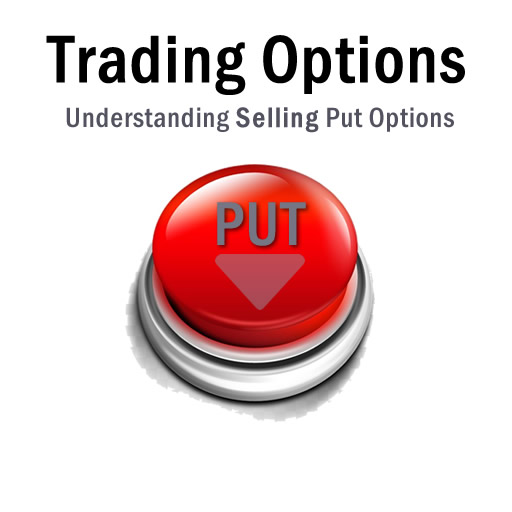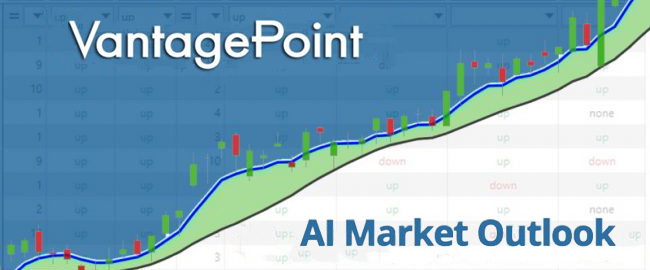Have you ever studied the returns of top hedge funds? Chances are that if you have, you have probably wondered how they consistently achieve superior returns. While there are thousands of possibilities one of the secrets that top hedge fund managers consistently employ is a way to use options as a risk management tool. In this article, we’re going to discuss specifically the strategy of selling put options to collect premium. On the surface this sounds about as exciting as watching paint dry, but when you comprehend the nuances, you will quickly see how mastering this one technique is often like purchasing stocks at an immediate discounted price.
A put option gives the buyer of the option, the right but not the obligation to sell a security at a specific price until a certain expiration date for a premium that they pay the creator of the option. The seller or creator of that option receives the premium and they have an obligation to purchase the shares at the agreed upon strike price should the buyer exercise the option.
While this sounds straightforward, an example will bring this concept to life and illustrate why it is one of the favorite trading techniques of successful risk managers.
Recently we wrote about the problems of Meta Platforms formerly known as Facebook. You can read our analysis here. In that stock study we pointed to the reality that $FB shares lost 26% year over year, just experienced their largest decline in history, despite having exceptional cash flow. A 1-year chart and a ten-year chart of $FB are below.
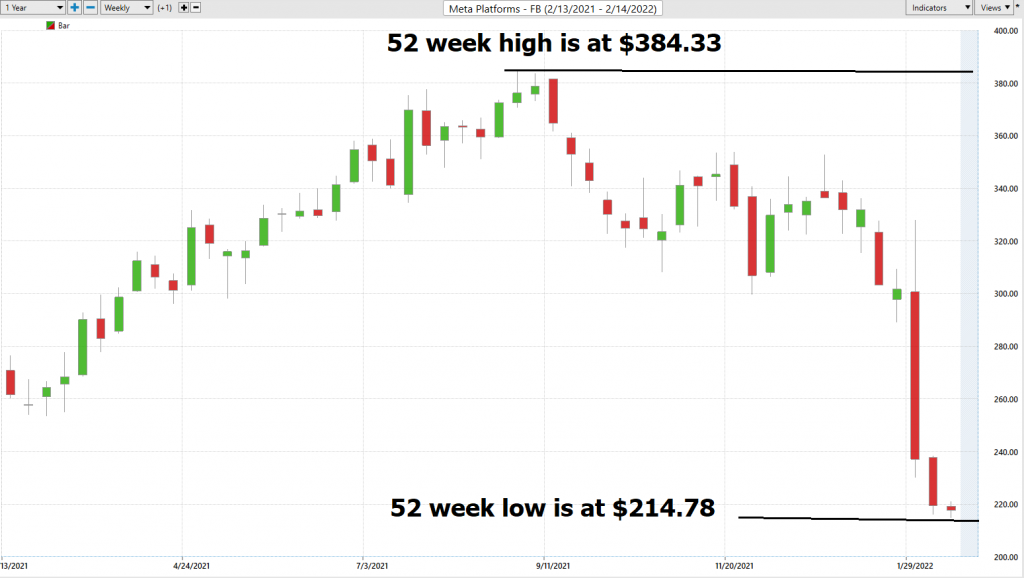
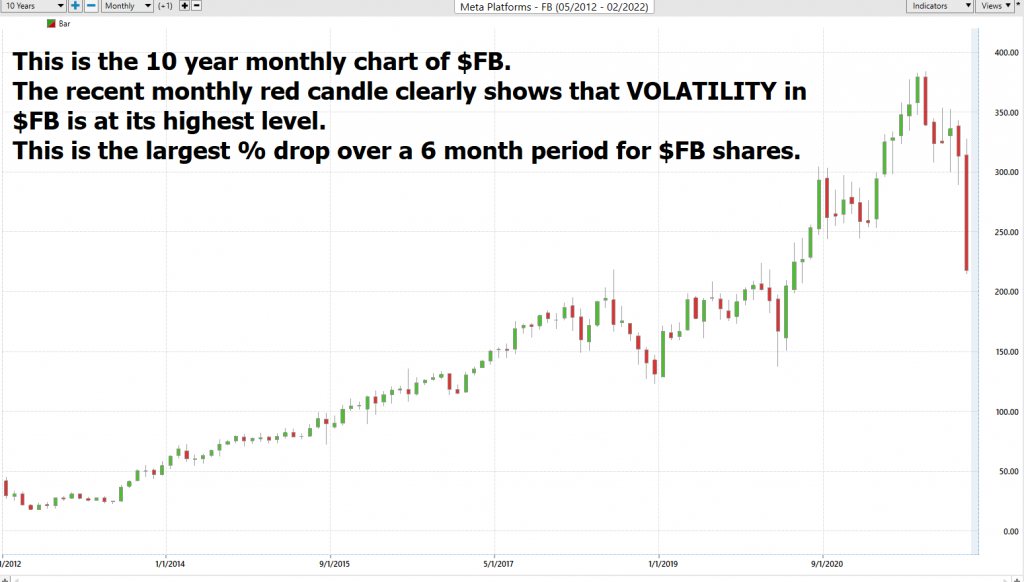
More importantly, based on 44 Wall Street analysts offering 12-month price targets for Meta Platforms in the last 3 months. The average price target is $332.14 with a high forecast of $466.00 and a low forecast of $225.00. The average price target represents a 50.29% change from the last price of $221.00.
Simply stated, Wall Street’s top minds think that $FB shares are fairly valued at about $117 higher than where $FB shares are currently trading. If these analysts are correct that would represent a better than 50% profit if you purchased the shares outright.
The problem for traders is that regardless how you look at $FB the trend is DOWN. Also, these analysts could be very wrong. $FB shares could go much lower.
Based upon these two considerations what type of strategy might a top hedge fund entertain to effectively chase yield while managing risk and putting the probabilities in their favor? I contend the strategy that hedge funds are considering right now on $FB shares is selling PUT options and collecting premium.
Whenever a trader SELLS or creates a PUT option, they are obligating themselves to buy the shares of the underlying stock at an agreed upon price between now and an expiration date. In exchange for that obligation, they are being paid a premium today which goes directly into their trading account. In other words, they are taking a very calculated specific and measurable risk. The most that a put option seller can make is the premium they collect. The most they can lose theoretically is the value of the strike price in case the value of the stock goes to zero. Options traders are not required to hold the position to expiration and can close out their positions at any time since these option contracts are usually very liquid.
On many actively traded indexes and stocks options often will expire every week. Weekly option series are listed each Thursday and expire the following Friday, except for those instances when the following Friday is a standard Expiration Friday (the third Friday of the month) or a quarterly expiration. $FB does have weekly options expiration which means that traders have a tremendous amount of choice as to how far out in the calendar they are willing to go and how much premium they are looking to receive.
Since Options are instruments that are only good for a specified period, they are considered to be deteriorating assets. All things being equal, an Option will be worth less tomorrow than it is today, simply because it is closer to the expiration date. What increases option prices is volatility in the underlying asset.
An Option is recognized as a deteriorating asset by savvy traders who use this understanding to create strategies that provide additional income to their portfolio while hopefully also minimizing risk.
A buyer of an Option has rights. To receive those rights, they will have to pay a premium payment to the Option seller.
A seller (creator) of an Option has obligations. They will be required to offset their position or fulfill their obligation if the market works against them.
What this means is, you can be the insurer and collect Option premiums in your account. However, before you do so, you need to understand that should the market move adversely, you will be required to either close out your position with a corresponding loss or fulfill the obligation that you created.
Selling Options for income is one of the few strategies where you can be completely wrong about the direction of the market and still win. This is because an Option is a deteriorating asset, and the premium will deteriorate exponentially the closer the Option is to the expiration date. By no means does this mean it is not risky. A seller of a put Option is obligating themselves to own the stock at the agreed upon strike price between now and the expiration date.
Differentiating the logic of option traders is very important in understanding these instruments.
An OPTION Buyer is looking to BUY Insurance and pay a premium.
An Option SELLER is “THE INSURANCE” and will collect the premium in exchange for creating the obligation.
Here is a simple example of Selling a Put Option on $FB shares.
First off, we need to look at the $FB option chain and we see that options expire on $FB almost every week.
For purposes of discussion, let’s look at the $200 strike price so that we could examine how much premium was available at that strike price level going out as far as 13 months. The recent 52-week lows on $FB are at $214.78.
When you look at this table recognize that the PUT Option BUYER is looking to BUY Insurance and pay that premium. The PUT Option Seller is looking to collect that PREMIUM and be obligated to a long position in $FB at the $200 strike price between now and the expiration date. A Put Option Seller recognizes the Premium amount is the maximum amount of money they could make if they sell the put option at that strike price and expiration date.
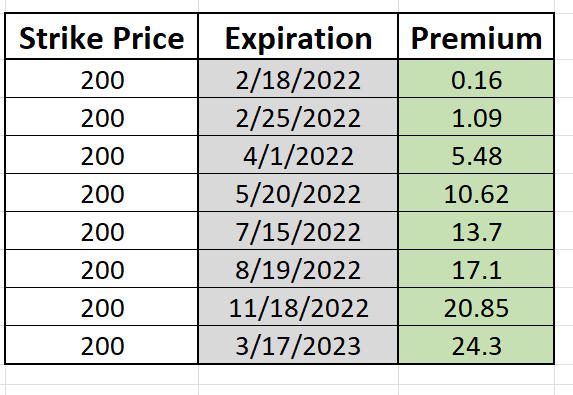
At the time of this writing, $FB is trading at roughly the $215.
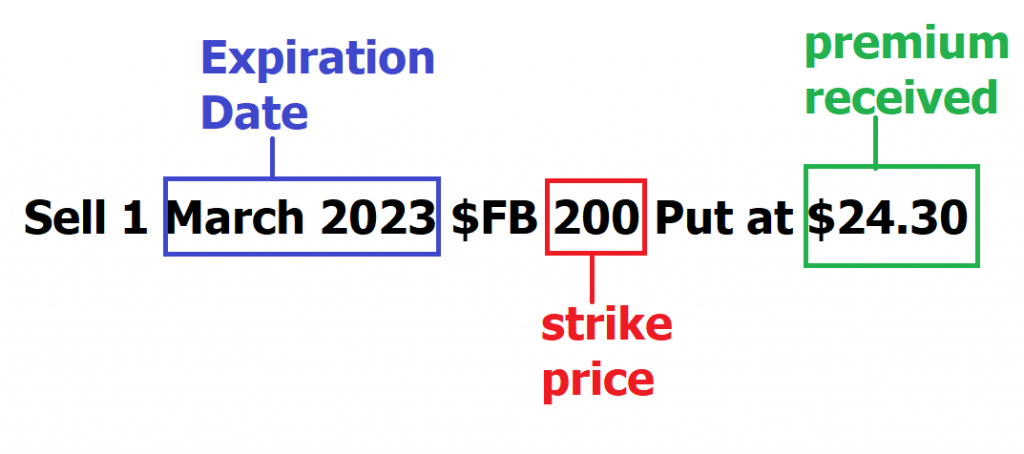
The thought process of an Option Seller is to closely examine the option expiration dates and the potential premium collected and think through the potential risks and rewards in the following manner.
What is their best-case scenario? (The amount of premium they can collect)
What is their worst-case scenario? (The stock goes to ZERO and they are obligated to purchase the shares at the $200 strike price)
The graph below illustrates what the maximum profit and loss on this hypothetical trade is.
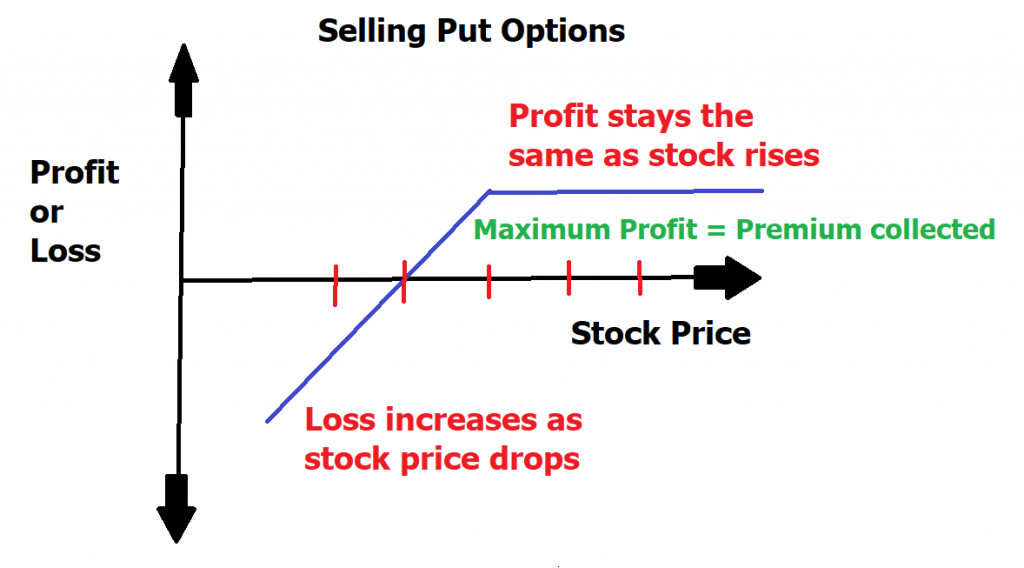
The maximum amount of money the PUT Option Seller can make is the premium collected. If the stock continues lower, they will be assigned a long position of 100 shares at the strike price of $200 per share. So, by selling the March 2023 $200 Put at $24.30 the maximum they can make is the premium of $24.30.

While this is unlikely it must be evaluated as part of the risk of this strategy.

Earlier in this article we saw Top Wall Street Analysts think that $FB is fairly valued at $332. Today it is trading at $215. The thought process of a hedge fund is to recognize that the trend in $FB shares is down but that the stock is heavily undervalued. If they sell the $200 Strike Price for March 2023 expiration, they collect $24.30 in premium today. Their break even on this trade as they consider it is that they would be assigned a long position of 100 shares at $200 per share but they keep the $24.30 premium. So, their net long position, actual cost would be the $200 strike price less the $24.30 premium received which equals $175.70.
If they think $FB is undervalued at $215 they are thrilled with the idea of owning the stock at $175.70. Since they are extremely well-capitalized, they are willing to hold on to this trade for the long term in anticipation that $FB shares will rebound in the future even if they do get assigned at $200 per share.
To appreciate the mindset of a hedge fund we must recognize that they always look at a worst-case scenario before jumping into a trade. Obligating themselves to own an undervalued asset at far below its fair value is an excellent probability trade if they manage the risk on their position. They are perfectly comfortable being the insurance for those who are bearish on the stock. But should $FB shares go to ZERO they would experience a loss of $200 per share on the stock but keep the premium of $24.30 per share.
The thought process is that at $200 the company is even more undervalued.
If someone is willing to pay them $24.30 obligating them to buy $FB at $200 that means that their breakeven price on the stock, should they get exercised would be $175.70 a share. So, they like $FB at $215 but at $175.70 should they get assigned they feel they are purchasing the stock at an even heavier discount.
While this strategy has proven to be very effective for hedge funds, short term traders apply this same type of thinking but are focused on the expiration date of the options contract. Please remember, in this hypothetical example, the expiration date is 13 months away. A lot can happen between now and the options expiration.
At any price over $200 the put option seller will collect the entire premium of $24.30.
At any price under $175.70 at expiration, this trade will lose money.
If going out 13 months on the calendar is considered too risky, put option sellers can choose whatever expiration they think will work best to their advantage. On the floors of the options exchanges, it is very common for traders to sell premium going into expiration and collect very small amounts. They refer to this on the floor as picking up “nickels in front of a slow-moving steamroller.”
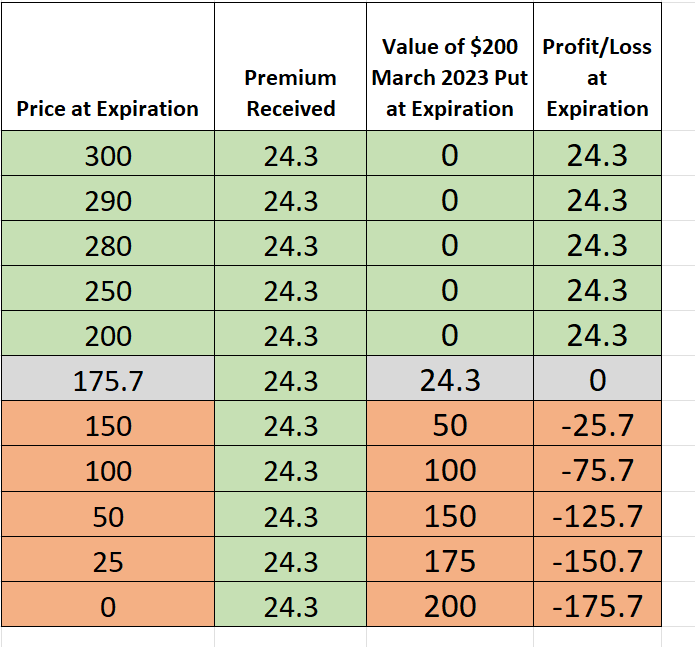
The fastest way for anybody coming to the options markets to genuinely understand the risk, rewards, and possibilities of this trading style if to open a demo account with your favorite broker and practice selling put options for at least 6 months before you do this in real time in your trading account.
You have to be very familiar with the risk and be prepared to liquidate the position quickly should the markets move against your position.
In the financial markets, option sellers become hyper-focused on time because TIME and volatility is what determines the price/cost of an option. All things being equal the more time an option has before it expires the more expensive it will be. Likewise, the more volatile an asset is the more uncertainty/risk exists about the future prospects of the asset, so the option will also be more expensive. But one fact that we know mathematically is the expiration date. So, we can pretty accurately estimate how much the value of the options will be worth with every passing week. This is very attractive to traders who are looking to create income from their trades. In these instances, traders will focus exclusively on options contracts that expire in the next 30 days because they recognize that the time decay of the options is exponential.
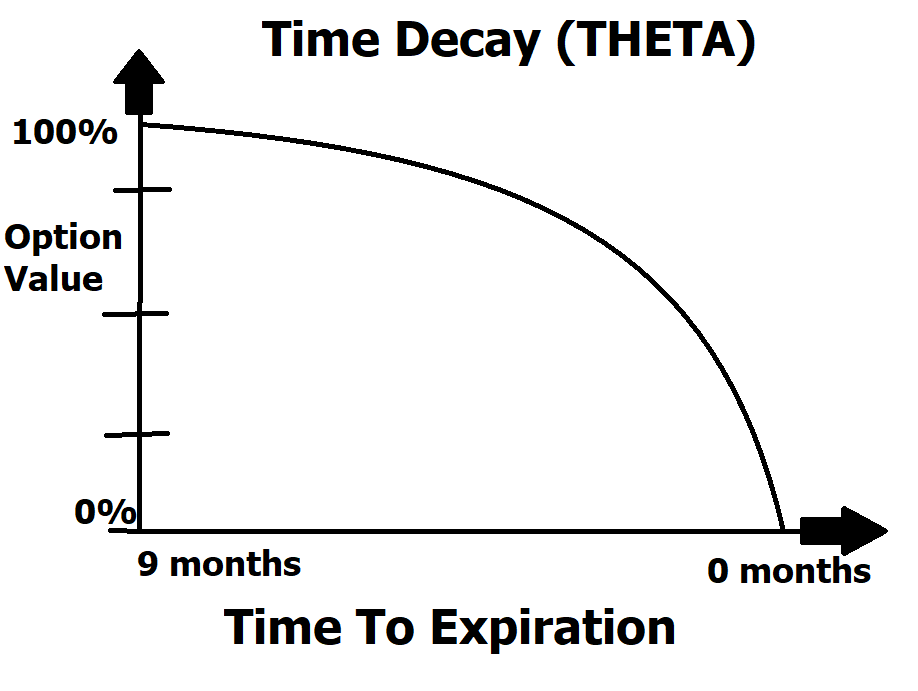
What makes this tactic extremely exciting is that whenever you sell a put option you can be completely wrong in terms of price movement and still make money. In our example, prices could fall all the way from current price levels of $215 to $177 and the put option seller would still be profitable at expiration. When this occurs you begin to appreciate the power and income that can be generated from time decay. But as I have discussed, selling put options is very nuanced and we always have to be aware that reward is limited to the premium collected, and risk is theoretically the strike price of the option in case the stock goes to zero.
Since many stocks have Options which expire every week, understanding the mechanics of this strategy are vital towards creating tactics that continue to put the odds in your favor while simultaneously creating income in your portfolio.
Final Note: This tactic can work phenomenally well in BULL markets. In other words, selling put options in up trending markets is literally like taking candy from a baby. In the example, I shared $FB is clearly in a downtrend. Implementing this tactic in a downtrend can work but it requires great skill and timing to eliminate unnecessary stress.
Selling put options is probably one of the absolute worst tactics to use in a genuine bear market.
Why?
Because you have limited reward and risk defined by the price of the stock which can drop substantially.
It’s important to understand this concept by practicing in a demo account and you will quickly come to understand the risks and possibilities.
What’s Your Best Chance to Make Money in The Financial Markets Today?
The Answer A.I. offers will surprise you.
Today Artificial Intelligence, Machine Learning and Neural Networks are an absolute necessity in protecting your portfolio. Imagine if you received a forecast that was up to 87.4% accurate about the direction of an underlying stock or Index 3 to 5 days in advance. Would that be valuable to you?
The job of A.I. is to find those stocks with the best trends, either Up or Down and highlight where the risk lies in that market.
Bad Traders Obsess on the SHOULD. Every other word out of their mouths’ is SHOULD.
I can’t recall how many times a trader has told me all the reasons why his portfolio is heavily invested in a stock because of a great story, despite the stock being in a firm downtrend.
But when “SHOULD” and “IS” meet some pretty explosive things can happen. And that is exactly where we want to be as traders!
Great trading is never about how much you make when you are right. It’s always about how little you lose when you are wrong. When you learn how to sell Options and collect premium you can be wrong and still make money.
Artificial intelligence is so powerful because it learns what doesn’t work, remembers it, and then focuses on other paths to find a solution.
Artificial Intelligence applies the mistake prevention as a continual process 24 hours a day, 365 days a year towards whatever problem it is looking to solve.
You can learn to sell PUT Options trade with minimal risk exposure and sound money management.
Be beautifully positioned before the herd even knows what happened.
Manage the RISK on the trade.
Lather. Rinse. Repeat.
The Answer AI offers may surprise you.
This is how some small traders grow their accounts by taking small bites out of the market consistently.
Today Artificial Intelligence, Machine Learning and Neural Networks are an absolute necessity in protecting your portfolio.
Intrigued? Visit with us and check out the a.i. at our Next Live Training.
Discover why artificial intelligence is the solution professional traders go-to for less risk, more rewards, and guaranteed peace of mind.
It’s not magic. It’s machine learning.
Make it count.
THERE IS A SUBSTANTIAL RISK OF LOSS ASSOCIATED WITH TRADING. ONLY RISK CAPITAL SHOULD BE USED TO TRADE. TRADING STOCKS, FUTURES, OPTIONS, FOREX, AND ETFs IS NOT SUITABLE FOR EVERYONE.IMPORTANT NOTICE!
DISCLAIMER: STOCKS, FUTURES, OPTIONS, ETFs AND CURRENCY TRADING ALL HAVE LARGE POTENTIAL REWARDS, BUT THEY ALSO HAVE LARGE POTENTIAL RISK. YOU MUST BE AWARE OF THE RISKS AND BE WILLING TO ACCEPT THEM IN ORDER TO INVEST IN THESE MARKETS. DON’T TRADE WITH MONEY YOU CAN’T AFFORD TO LOSE. THIS ARTICLE AND WEBSITE IS NEITHER A SOLICITATION NOR AN OFFER TO BUY/SELL FUTURES, OPTIONS, STOCKS, OR CURRENCIES. NO REPRESENTATION IS BEING MADE THAT ANY ACCOUNT WILL OR IS LIKELY TO ACHIEVE PROFITS OR LOSSES SIMILAR TO THOSE DISCUSSED ON THIS ARTICLE OR WEBSITE. THE PAST PERFORMANCE OF ANY TRADING SYSTEM OR METHODOLOGY IS NOT NECESSARILY INDICATIVE OF FUTURE RESULTS. CFTC RULE 4.41 – HYPOTHETICAL OR SIMULATED PERFORMANCE RESULTS HAVE CERTAIN LIMITATIONS. UNLIKE AN ACTUAL PERFORMANCE RECORD, SIMULATED RESULTS DO NOT REPRESENT ACTUAL TRADING. ALSO, SINCE THE TRADES HAVE NOT BEEN EXECUTED, THE RESULTS MAY HAVE UNDER-OR-OVER COMPENSATED FOR THE IMPACT, IF ANY, OF CERTAIN MARKET FACTORS, SUCH AS LACK OF LIQUIDITY. SIMULATED TRADING PROGRAMS IN GENERAL ARE ALSO SUBJECT TO THE FACT THAT THEY ARE DESIGNED WITH THE BENEFIT OF HINDSIGHT. NO REPRESENTATION IS BEING MADE THAT ANY ACCOUNT WILL OR IS LIKELY TO ACHIEVE PROFIT OR LOSSES SIMILAR TO THOSE SHOWN.





